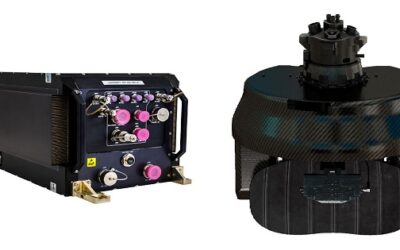Analysis: Weekend Syria strikes expose moribund condition of country’s air defences
Following days-long overtures of characteristic bluster traded between the respective US and Russian administrations of Presidents Donald Trump and Vladimir Putin, it was safe to say that any vestige of bonhomie which had existed between these two gentlemen evaporated following the US-led air strikes against chemical weapons targets belonging to the regime of Syria’s President Bashir al-Assad in the early morning of 14 April. In the hours before the salvoes of British, French and US surface- and air-launched cruise missiles struck their aim points near the cities of Homs and Damascus in the west of the country, the Russian government had threatened dire consequences if the US and her allies commenced the attacks which had been threatened in the wake of the attack using chlorine gas against the city of Douma in southwestern Syria on seven days earlier which has been widely blamed on Mr. Assad’s forces. Prior to the attacks, Russia’s ambassador to the United Nations had criticised US threats to use force as “reckless” and accused the US-led coalition including France and the United Kingdom as using the attacks as a smokescreen for a strategy to unseat Mr. Assad, and to contain Russia.
The interregnum between the chlorine attack, and the missiles hitting their targets, was punctuated by prophecy and speculation regarding the sharpness of Russia’s deployed ground-based air defences in the Syrian theatre of operations, and their ability to blunt, or curtail completely, any US-led air attacks. As it was, reports in the immediate aftermath of the attacks indicated that all 105 missiles had hit their targets, despite statements by the official Syrian SANA news agency, backed by Russia, that 71 of the weapons were brought down. Both the Russian and Syrian government’s penchant for mendacity makes one take such claims with at least a teaspoon of salt. The US-led coalition denies that any of the missiles were shot down, and neither the Syrian or Russian governments have volunteered to display any evidence to this effect, such as the wreckage of any missiles: A prominent manufacturer’s serial number on a scrap of burnt and twisted airframe would surely be too much of a propaganda coup to keep hidden from the world’s television screens.
So why did neither the Russian or Syrian ground-based air defences succeed in hitting their targets? Firstly, it is entirely possible that the Russian ground-based air defences were not ordered into action. It is well known that Moscow has deployed two of its advanced Almaz-Antey S-400 Trimuf (NATO reporting name SA-21 Growler) high-altitude Surface-to-Air Missile (SAM) batteries into the Syrian theatre. While these are robust systems which have yet to be encountered by the US or her allies in combat, using them would present Mr. Putin with a dilemma. Firstly, should one of these batteries, or indeed any other of the deployed Russian ground-based air defences succeed in hitting one of the incoming missiles, for all intents and purposes, this would place Russia in a direct shooting war with the US, risking a significant escalation should the US then perform a systematic Offensive Counter Air campaign to neutralise both these and Syria’s ground-based air defences in an attempt to sanitise the airspace above the Syrian theatre. Despite the harsh words coming out of Washington DC and Moscow, and the warnings of UN Secretary General Antonio Guterras that the Cold War is “back with a vengeance”, such an escalation is neither desired, nor meets the long-term strategic interests, of either nation both of which would like to extricate themselves from the Syrian civil war at some point in the near future. Secondly, use your ground-based air defences and you show your hand to the electronic intelligence aircraft no doubt quietly snooping around Syrian air space listening to the tell-tale communications and radar radio frequency emissions which can then be used to refine electronic warfare tactics for any future operations to not only help to protect combat aircraft, but also assist air defence suppression efforts at the operational level writ large against the Syrian Integrated Air Defence System (IADS). For example, the US Air Force’s strike package of Rockwell International/Boeing B-1B Lancer strategic bombers which launched a total of 19 Lockheed Martin AGM-158 Joint Air-to-Surface Standoff Missile-Extended Range weapons were reportedly protected by a combat air patrol and a solitary Northrop Grumman EA-6B Prowler from the US Marine Corps with this aircraft no doubt providing powerful electronic attack support for these aircraft.
Anecdotal evidence from reporters and video uploaded to social media suggested that the Syrian IADS did try to engage the incoming missiles, but with no success, with the US Department of Defense later saying that up to 40 SAMs were fired against the incoming missiles, but these were only launched after the weapons had reached their targets suggesting a woeful lack of Situational Awareness (SA) on the part of the Syrian IADS. As a consequence of this lack of SA, SAM and AAA fire was badly coordinated and lacked precision. This lack of situational awareness could have resulted from the US-led coalition performing significant jamming and cyber attacks against the Syrian IADS, as the presence of the EA-6B seems to suggest regarding the former. The Israeli Air Force (IAF) is a veteran of such actions having attacked Syria’s fledgling nuclear reactor in the east of the country on 7 September 2007 which was successfully executed and was thought to include significant jamming, and may have also included a cyberattack, against the Syrian IADS ground-based air surveillance and fire control/ground-controlled interception radar. It can safely be presumed that the US-led coalition and the Israelis have probably shared valuable intelligence on the workings of the Syrian IADS. Secondly, the Syrian IADS has now experienced seven years of war. While it has exacted some notable success, such as the downing of an IAF Lockheed Martin F-16I on 10 February, it has been either unable and/or unwilling to meaningfully engage the armada of US and coalition aircraft which regularly traverse its skies. Last but by no means least, the Syrian IADS as also battling against a strike which comprised Raytheon BGM-109C Tomahawk surface-to-surface missiles launched by US Navy vessels in the Mediterranean, and MBDA SCALP-EG/Storm Shadow air-to-surface missiles launched by Armée de l’Air (French Air Force) Dassault Rafale-F3A/B and Royal Air Force Panavia Tornado-GR4 combat aircraft. The SCALP-EG/Storm Shadow and the AGM-158 were all designed from the outset to present a low radar cross section making them fiendishly difficult to shoot down, while following flight profiles which help to mask them to radar. Moreover, all the missiles involved in the attack will have followed a flight profile designed to reduce their exposure to radar. Similarly, the US Navy is a veteran of using this sharp instrument of ‘politics by other means’ and has finely honed the skills of deploying this weapon in such a fashion as to make it a challenging target, as air defenders in Iraq, Libya and Serbia would no doubt attest. Ultimately, the US-led strike hits its mark, but the Syrian IADS did not, betraying their impotence, and the reluctance of Syria’s Russian allies to escalate a fragile situation any further.
Thomas Withington

























